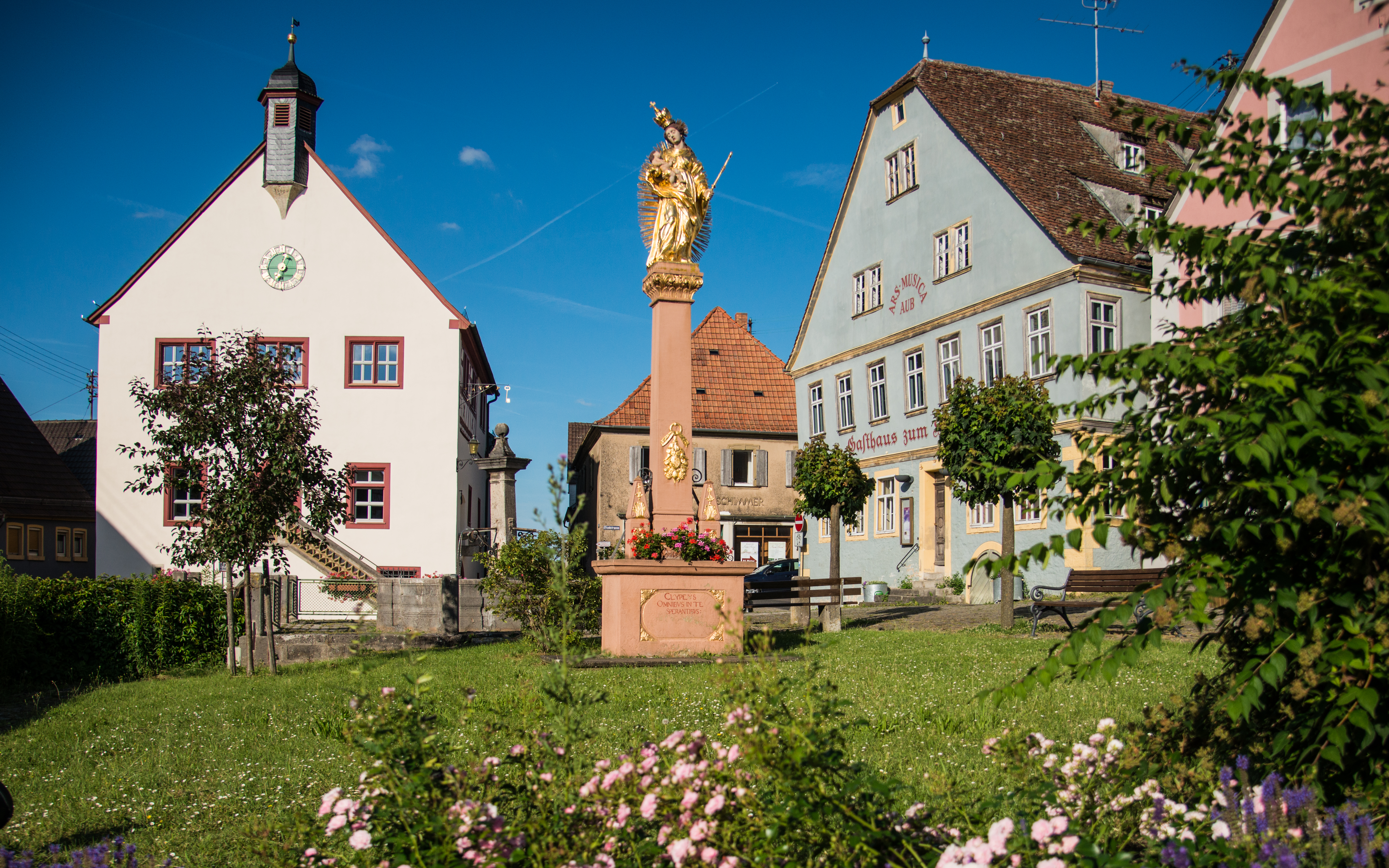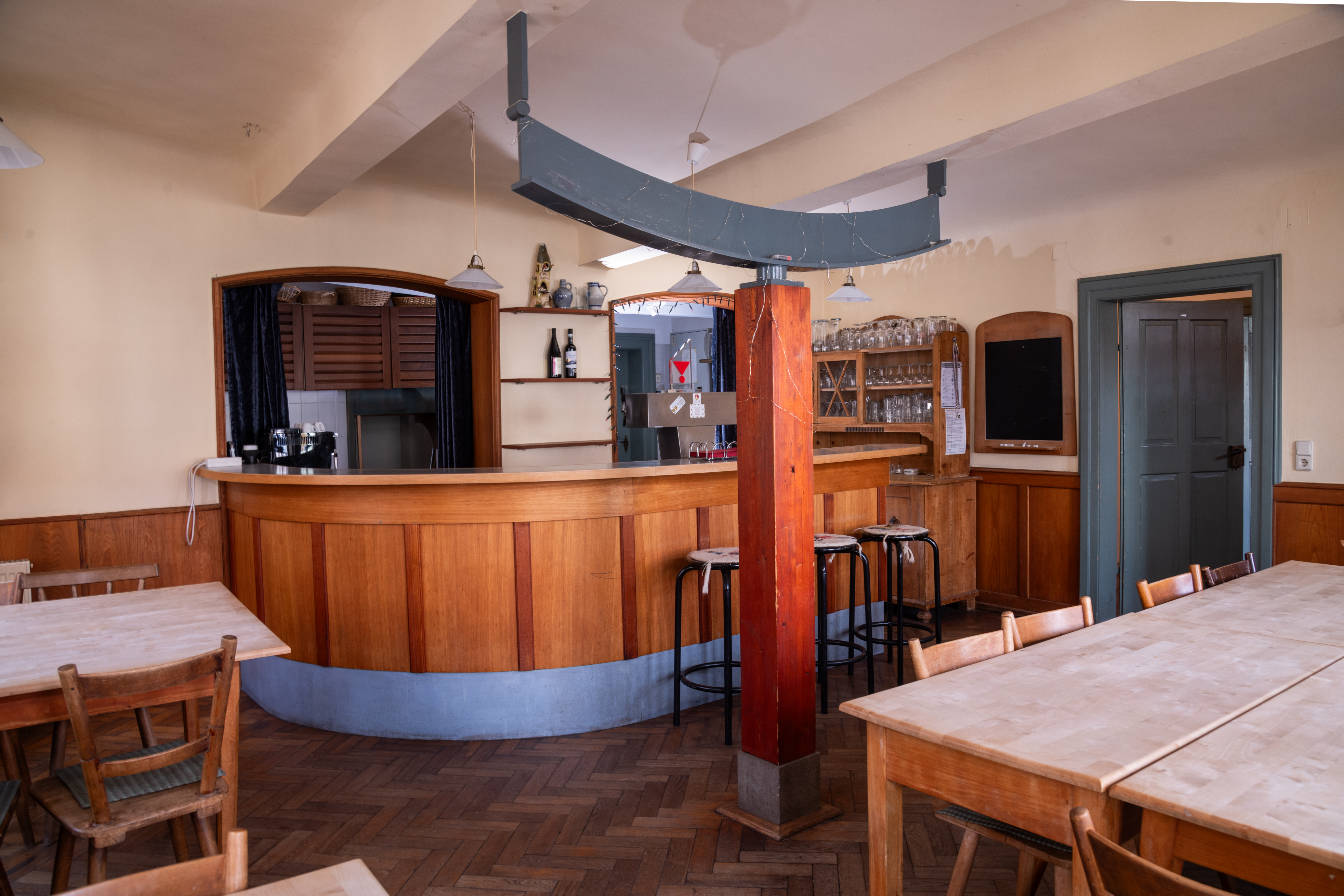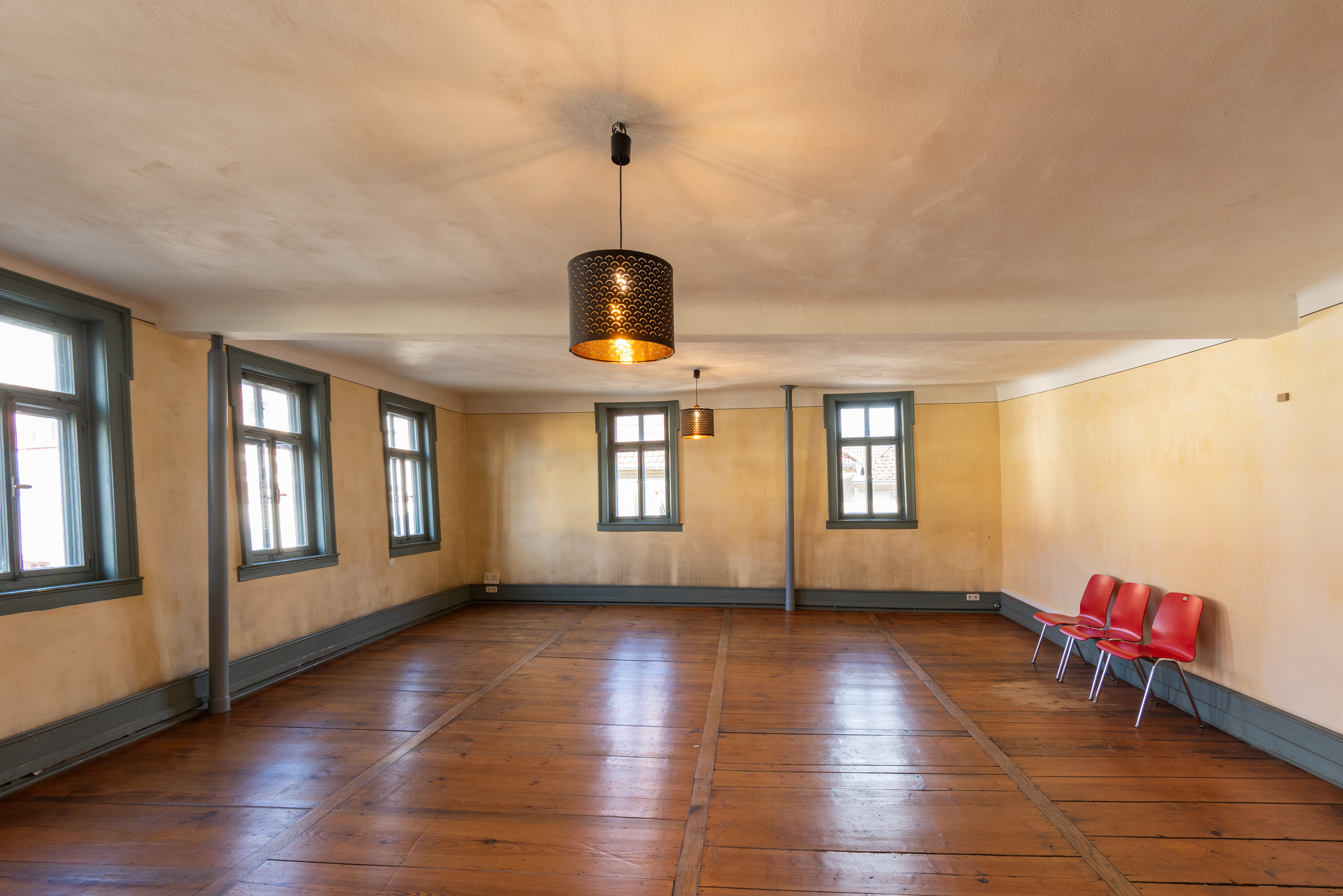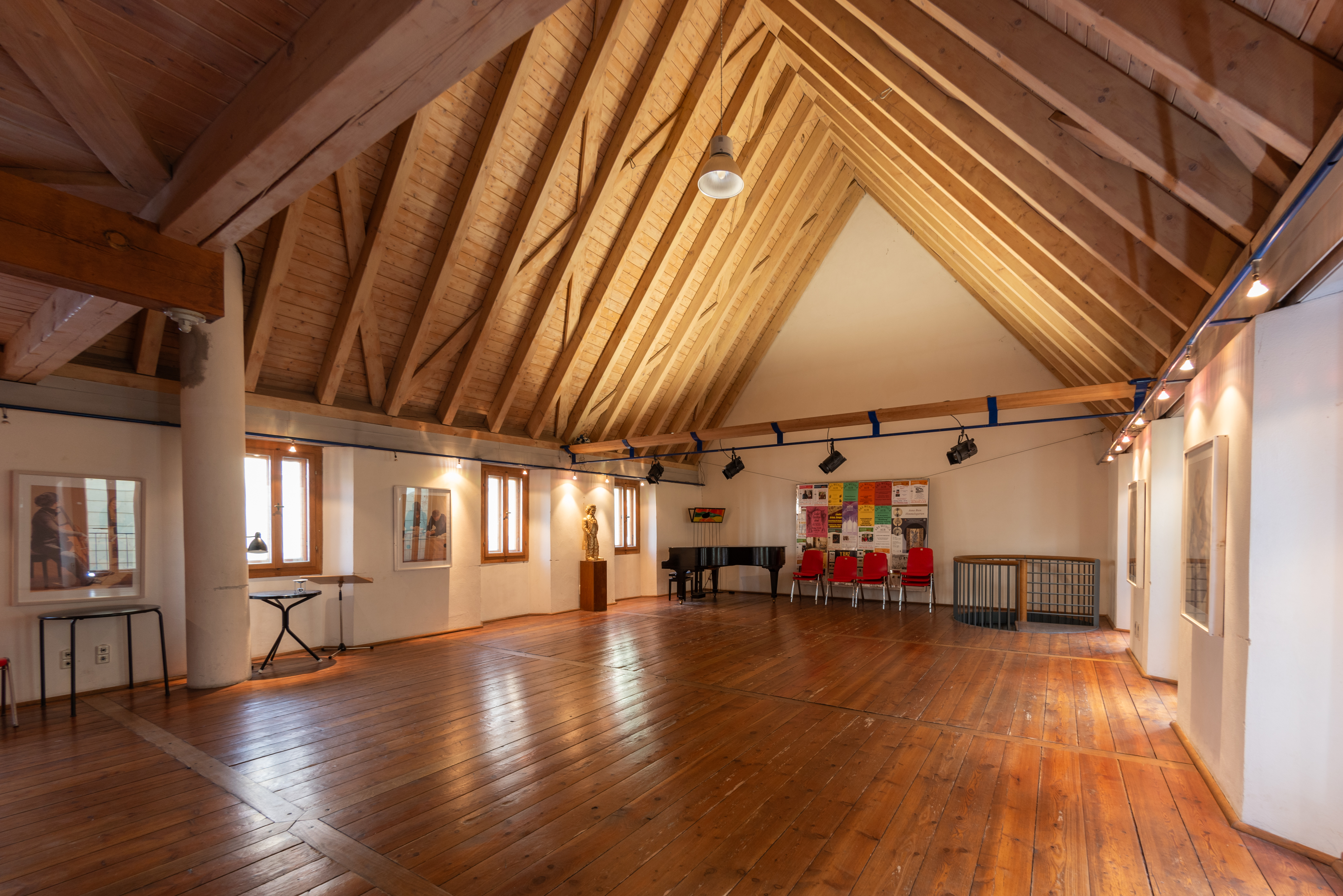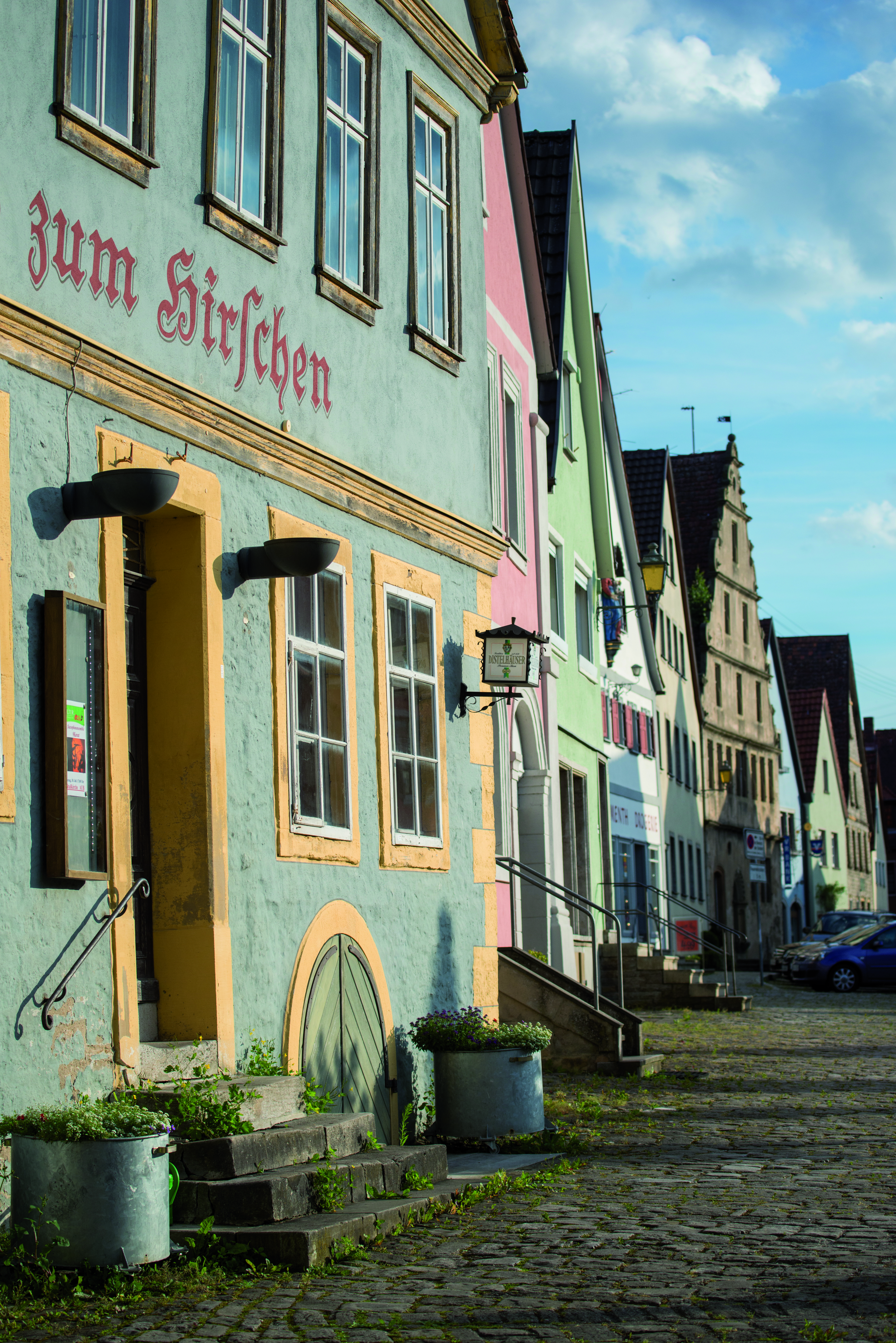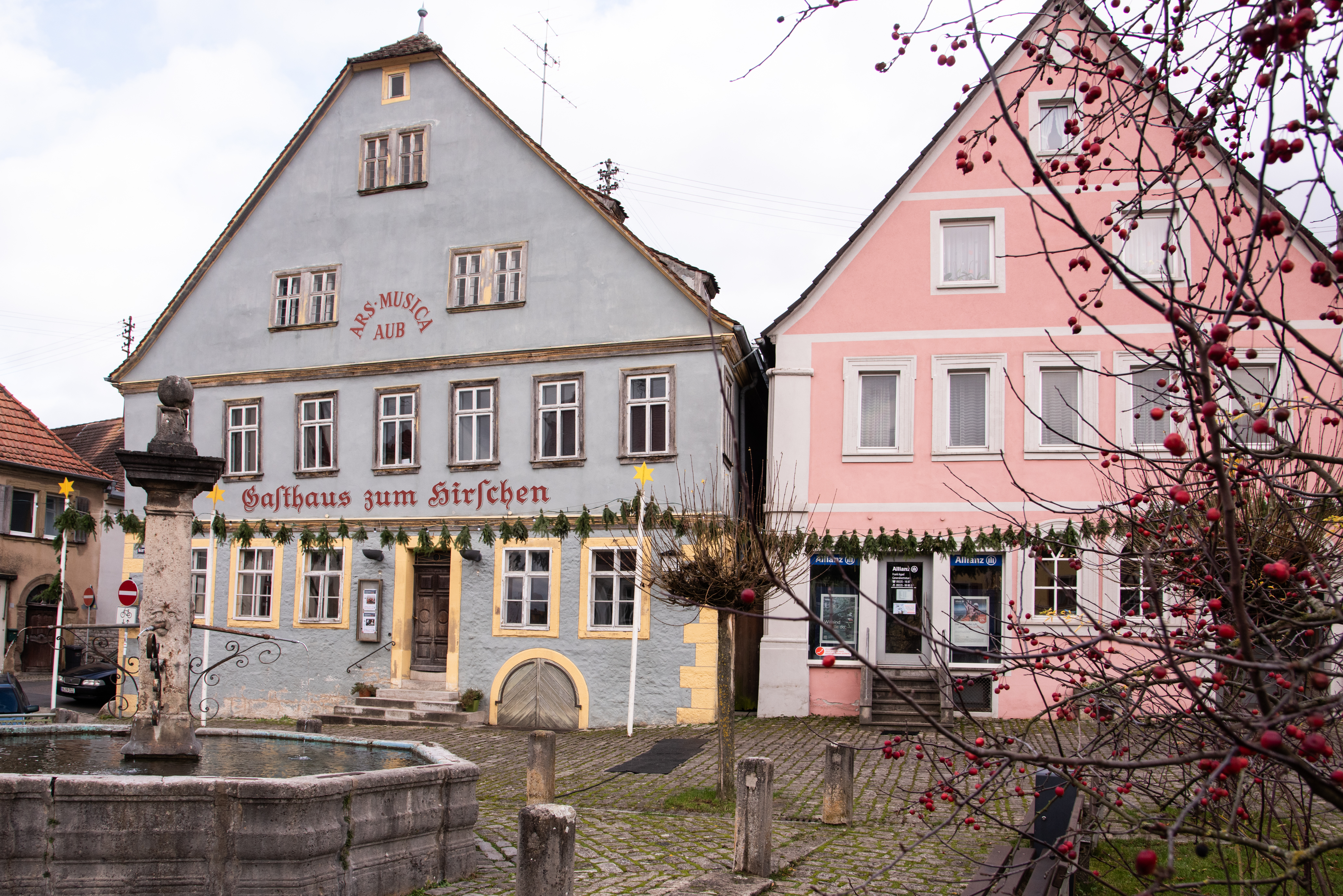Ars Musica - Hometown Forum in Aub
Ars Musica - Hometown Forum in Aub: Linking History and Future of a Small Town Community
Ars Musica - Our Hometown Forum in Aub is about the smart and climate-friendly transformation of a historic building in the town centre into a hub for civic activities, e.g. music and arts practice and performance, and as a shared meeting point for the many associations and clubs we have. The concept of a hometown forum creates a shared identification point for citizens of all ages and backgrounds, linking the rich history of our small municipality to a positive future outlook as a smart town.
Germany
Ars Musica
Marktplatz 3
97239 Aub
Marktplatz 3
97239 Aub
Prototype level
Yes
Yes
Yes
No
No
09679114: Aub, St (DE)
Overall aim of the initiative is sustainable and climate-responsible town development and active community life facilitated by our built environment. Our means is the renovation and re-purposing of an existing historic building in the town centre for use by a very active citizenry.
Specific objectives are:
a) Sustainable use of existing structures: the renovation avoids new construction and limits land use, civic works and building equipment will be carried out in a CO2- and climate-conscious way, e.g. by building in new windows and modern heating.
b) Setting a positive signal for urban development through revitalisation of a historic monument: the building is part of a 17th century ensemble around the town square. Its renovation will send a signal against decay and for the attractiveness of the town centre.
c) Providing a common hub for community life and strengthening cohesion: our town population of less than 1500 is very active in over 30 associations, so far with insufficient meeting and activity space.
d) Using culture as a vector for small-town revitalisation and stimulation of tourism: we already have a rich cultural programme with regional significance, drawing visitors even from the regional centre Würzburg. The initiative will give these activities a better home.
e) Bridging legacy and future: the initiative will offer smart digital solutions for bookings and better coordination among the associations, for information sharing with citizens, and for linking the associations with the support offers they can receive at county and state levels. The initiative will be model part of a Smart Region approach.
Target groups are the over 30 active civic associations in town, with interests spanning from arts and music to folklore and handicrafts, dance and sport. The building will also serve as a venue for townhall meetings targeting the general citizenry. Expected outcome is the long-term provision of a widely accepted hub for active community life.
Specific objectives are:
a) Sustainable use of existing structures: the renovation avoids new construction and limits land use, civic works and building equipment will be carried out in a CO2- and climate-conscious way, e.g. by building in new windows and modern heating.
b) Setting a positive signal for urban development through revitalisation of a historic monument: the building is part of a 17th century ensemble around the town square. Its renovation will send a signal against decay and for the attractiveness of the town centre.
c) Providing a common hub for community life and strengthening cohesion: our town population of less than 1500 is very active in over 30 associations, so far with insufficient meeting and activity space.
d) Using culture as a vector for small-town revitalisation and stimulation of tourism: we already have a rich cultural programme with regional significance, drawing visitors even from the regional centre Würzburg. The initiative will give these activities a better home.
e) Bridging legacy and future: the initiative will offer smart digital solutions for bookings and better coordination among the associations, for information sharing with citizens, and for linking the associations with the support offers they can receive at county and state levels. The initiative will be model part of a Smart Region approach.
Target groups are the over 30 active civic associations in town, with interests spanning from arts and music to folklore and handicrafts, dance and sport. The building will also serve as a venue for townhall meetings targeting the general citizenry. Expected outcome is the long-term provision of a widely accepted hub for active community life.
European local identity
Resourcefulness and sustainability
Smart town in a smart region
Attractive small-town urbanity
Civic dialogue and active citizens
The use of an existing building and its repurposing supports resourcefulness and sustainability. A large number of local associations will use the building for their activities, bundling and reducing their need for space. Both aspects help limit the need for building material, resources (water, energy) and additional land use. A new, CO-2 reduced heating will be built in, and new windows for better insulation. Solar panels will be used in line with zoning regulations.
The building requires renovation works that will need to blend in with its historic substance. Natural materials from regenerative sources (mainly wood) are the obvious choice. All necessary renovation works will be carried out in a CO2-emission- and climate-conscious way. Heating will be de-carbonised, additional insulation will help reduce heat loss.
Planning requires a careful balance of historic preservation and its legal requirements, inner town zoning regulations, and climate-friendly standards fit for the 21st century and supporting EU climate-neutrality targets. As a small municipality, we also need to find a realistic balance between resources and ambition on basis of a sustainable financing strategy. These challenges and the model character of the initiative are recognised and supported by the county authorities and will serve as orientation for other small municipalities in the region with similar infrastructure.
The building requires renovation works that will need to blend in with its historic substance. Natural materials from regenerative sources (mainly wood) are the obvious choice. All necessary renovation works will be carried out in a CO2-emission- and climate-conscious way. Heating will be de-carbonised, additional insulation will help reduce heat loss.
Planning requires a careful balance of historic preservation and its legal requirements, inner town zoning regulations, and climate-friendly standards fit for the 21st century and supporting EU climate-neutrality targets. As a small municipality, we also need to find a realistic balance between resources and ambition on basis of a sustainable financing strategy. These challenges and the model character of the initiative are recognised and supported by the county authorities and will serve as orientation for other small municipalities in the region with similar infrastructure.
The building offers historic beauty as a classified monument, and the repurposing signifies the value and relevance of our legacy also for modern community life. The central location of the building on the town square and its beauty offer a positive identification point for citizens and visitors alike. The building will offer outside space for meeting and socialising blended in with the town square and its historic character.
The initiative is the new centrepiece of an integrated urban development framework established already in in 2016, which aims at keeping the town centre vital while preserving its historic character, offering attractive housing within existing structures and minimal additional land use, and increasing the potential of additional income from local business and tourism. The initiative will help to boost and sustain our initiative to market old and increasingly dilapidating buildings in the town centre as attractive homesteads and business locations compatible with modern aesthetic preferences and quality of life demands of our citizens.
The exterior of the building will be renovated in line with historic monument protection regulations, and its original shape will be preserved for future generations. Interior design will offer a mix of history and modernity in an aesthetically appealing way, blending old and new materials and designs, also as an inspiration for other renovation works, both in the public and private sphere.
Our local population identifies strongly with the building, and it is well known in the region, also thanks to the music and cultural performances it has already been hosting as part of a well-established citizens’ initiative for music performances across all genres, the “Ars Musica”. Cultural activities are integral part of our branding and city marketing, as expressed in our municipal motto “Small Town – Big Joy”.
The initiative is the new centrepiece of an integrated urban development framework established already in in 2016, which aims at keeping the town centre vital while preserving its historic character, offering attractive housing within existing structures and minimal additional land use, and increasing the potential of additional income from local business and tourism. The initiative will help to boost and sustain our initiative to market old and increasingly dilapidating buildings in the town centre as attractive homesteads and business locations compatible with modern aesthetic preferences and quality of life demands of our citizens.
The exterior of the building will be renovated in line with historic monument protection regulations, and its original shape will be preserved for future generations. Interior design will offer a mix of history and modernity in an aesthetically appealing way, blending old and new materials and designs, also as an inspiration for other renovation works, both in the public and private sphere.
Our local population identifies strongly with the building, and it is well known in the region, also thanks to the music and cultural performances it has already been hosting as part of a well-established citizens’ initiative for music performances across all genres, the “Ars Musica”. Cultural activities are integral part of our branding and city marketing, as expressed in our municipal motto “Small Town – Big Joy”.
Ground-floor renovation of the building will create a barrier-free environment for better access and inclusion of physically challenged persons. Sanitary facilities will be reconstructed for public use, accessible also outside operating hours of the building.
Modern IT infrastructure will be used to inform about and to coordinate activities among the associations and with the general public, making information sharing as inclusive as possible. It will also be used to establish a virtual network for experience sharing and joint activities among communities at county level, and as backbone for a professional counselling and support network for community volunteers, managed by the county administration.
Some of the local associations reach out actively to a refugee housing facility operating in town conflict-free since decades, also thanks to our citizen engagement. This works well as a positive people-to-people integration factor. The municipality has been supporting some of these efforts financially. The initiative will provide a suitable venue to continue and strengthen such activities.
Local associations, and particularly “Ars Musica” (the association behind an existing initiative for live music performances and concerts giving the name to this new initiative) work with audience donations rather than entry fees for their events, a concept that is widely accepted and ensures wide outreach and inclusion of all citizens independently of income. Performer honorariums are topped up from a regular subsidy provided by the town administration, which supports the concept.
Modern IT infrastructure will be used to inform about and to coordinate activities among the associations and with the general public, making information sharing as inclusive as possible. It will also be used to establish a virtual network for experience sharing and joint activities among communities at county level, and as backbone for a professional counselling and support network for community volunteers, managed by the county administration.
Some of the local associations reach out actively to a refugee housing facility operating in town conflict-free since decades, also thanks to our citizen engagement. This works well as a positive people-to-people integration factor. The municipality has been supporting some of these efforts financially. The initiative will provide a suitable venue to continue and strengthen such activities.
Local associations, and particularly “Ars Musica” (the association behind an existing initiative for live music performances and concerts giving the name to this new initiative) work with audience donations rather than entry fees for their events, a concept that is widely accepted and ensures wide outreach and inclusion of all citizens independently of income. Performer honorariums are topped up from a regular subsidy provided by the town administration, which supports the concept.
Our town enjoys a long history of civic engagement in its cultural life. Specifically “Ars Musica”, an association of active performers and supporters of (mainly) classical music have since more than 25 years offered programmes with regularly 20 or more performances per year, which are well accepted and attended by the locals but also pull regional audiences. This has made Aub and its cultural programme a regional household name (www.ars-musica.de). Ars Musica had so far rented the venue proposed for this initiative on a private basis. It is the explicit wish of the building owner that this private partnership is transferred to public ownership, and thereby sustained. This has opened the possibility to widen the use of the building by bringing in other associations as co-users, an opportunity that was immediately and widely accepted. The municipality has secured state and federal financial support through dedicated programmes for the purchase of the object, which is now completed.
Preparation of the proposal to create “Ars Musica - Hometown Forum in Aub” builds on a well-established general consultative mechanism between citizenry, its associations, and municipal administration, using the formats of regular and ad-hoc meetings. Many of the associations have the explicit goal of strengthening and supporting community life in their statutes, e.g. through beautification programmes, action days, and cultural performances. A dedicated consultation process has taken place for the purpose of this initiative, securing sufficient buy-in from the local associations to the concept of a shared venue; this has gained broad support and strengthened process ownership (see attachments).
Preparation of the proposal to create “Ars Musica - Hometown Forum in Aub” builds on a well-established general consultative mechanism between citizenry, its associations, and municipal administration, using the formats of regular and ad-hoc meetings. Many of the associations have the explicit goal of strengthening and supporting community life in their statutes, e.g. through beautification programmes, action days, and cultural performances. A dedicated consultation process has taken place for the purpose of this initiative, securing sufficient buy-in from the local associations to the concept of a shared venue; this has gained broad support and strengthened process ownership (see attachments).
The municipality has repeatedly held large citizen participation formats in recent years, to which the local citizenry is well acquainted. Examples of this include establishment of an inter-municipal alliance (www.fraenkischer-sueden.de) which has influenced our urban development planning and shared regional development activities in an inclusive way.
Specifically for the purchase of the building proposed for the initiative, all local associations interested in the concept of a shared multiple-use venue were invited to dedicated planning meetings. This has led swiftly to an agreement of a usage concept for a shared club and cultural centre.
For its implementation, the initiative receives support from a county level platform for the creation of a Smart Region for social resilience, which combines analogue and digital offers oriented towards the needs of communities (https://www.stadt-land-wue.de/stadtlandwue/smarte-region-wuerzburg/index.html). The Smart Region currently offers information tools, open data for regional use, and facilitation of participatory planning processes. It supports an application of our initiative for federal financial support through KfW.
Smart Region Würzburg considers our initiative as a flagship, with the intention to generate lessons for replicability in other small towns with similar demographics and economic challenges. From this process, we expect a widening of our stakeholder platform, through peer exchange with other communities in our region.
Specifically for the purchase of the building proposed for the initiative, all local associations interested in the concept of a shared multiple-use venue were invited to dedicated planning meetings. This has led swiftly to an agreement of a usage concept for a shared club and cultural centre.
For its implementation, the initiative receives support from a county level platform for the creation of a Smart Region for social resilience, which combines analogue and digital offers oriented towards the needs of communities (https://www.stadt-land-wue.de/stadtlandwue/smarte-region-wuerzburg/index.html). The Smart Region currently offers information tools, open data for regional use, and facilitation of participatory planning processes. It supports an application of our initiative for federal financial support through KfW.
Smart Region Würzburg considers our initiative as a flagship, with the intention to generate lessons for replicability in other small towns with similar demographics and economic challenges. From this process, we expect a widening of our stakeholder platform, through peer exchange with other communities in our region.
Planning has followed and will continue a multi-disciplinary approach, bringing together architecture and town planning, historic conservation and restoration, arts and music, and a diverse and engaged citizenry. It has strong elements of a participatory process, with regular consultations and active involvement of the community in the planning process that will be continued in the further planning, construction and operation process. Aspects of historic preservation are particularly important, and the relevant authorities are part of the multidisciplinary approach, with financial support for preservation works coming from county and regional authorities.
The innovative character of our initiative lies in its multi-dimensionality:
- A clear commitment to wide stakeholder consultation and participatory planning
- Multi-disciplinary and interdisciplinary planning embedded in a consultative process, for better planning outcomes
- The expectation of a high degree of self-governance by the members of the initiative and a high degree of citizen ownership and identification with the facility during its operation
- Moving beyond a stand-alone initiative and integrating it as part of a Smart Region concept, interlinking communities for peer exchange
- Smart use of IT as an enabling and supporting tool, particularly to support the work of individual and small group volunteers: to give them a sense of community beyond local boundaries, a sense of being recognised and not left alone, and the possibility of peer learning.
- A clear commitment to wide stakeholder consultation and participatory planning
- Multi-disciplinary and interdisciplinary planning embedded in a consultative process, for better planning outcomes
- The expectation of a high degree of self-governance by the members of the initiative and a high degree of citizen ownership and identification with the facility during its operation
- Moving beyond a stand-alone initiative and integrating it as part of a Smart Region concept, interlinking communities for peer exchange
- Smart use of IT as an enabling and supporting tool, particularly to support the work of individual and small group volunteers: to give them a sense of community beyond local boundaries, a sense of being recognised and not left alone, and the possibility of peer learning.
The initiative is new centrepiece of an integrated urban development framework established already in in 2016, which aims at keeping the town centre vital, offering attractive housing within existing structures and minimal additional land use, and increasing the potential of additional income including from tourism. Our project is embedded in two regional initiatives, “Fränkischer Süden” and “Smart Region Würzburg” which support integrated and multi-disciplinary planning, tapping into a wider pool of expertise and offering the possibility of lesson-sharing.
Use of smart IT in all operational aspects of our initiative and its integration in the Smart Region network offers innovative potential in data and information sharing, coordination and inter-linking, and in connecting a local initiative with its wider regional, national, European and global context.
Use of smart IT in all operational aspects of our initiative and its integration in the Smart Region network offers innovative potential in data and information sharing, coordination and inter-linking, and in connecting a local initiative with its wider regional, national, European and global context.
The design of “Smart Region Würzburg”, of which our initiative is a flagship part, is particularly geared towards peer exchange, mutual learning, transfer of knowledge and experience, and replication of successful models both in person-to-person interaction and using the means of smart IT for data sharing and communication. We expect to be able to share lessons from our model approach from an early stage. Possible lessons include the process of coordination between different citizens associations towards common goals and strategies, working with public authorities at all levels, the shared use of resources, but also the very hands-on experiences from renovating and making a listed historic building fit for purpose as a modern community house. . At county level, there is specific interest in developing our approach as a model for the preservation and functionality of historic buildings for community life.
Our town shares with many other European rural communities the challenges of declining economic activity and reduced employment, changing demography, limited connectivity, and decaying infrastructure. Our aim is to prove that a local approach building on appealing/aesthetic infrastructure in combination with social activities will strengthen positive local identification, making small town life more attractive and convincing younger community members and families to stay.
At global level, our initiative supports UN SDG 11 (inclusive, safe, resilient and sustainable cities), particularly in these targets:
- 11.3 (participatory, integrated and sustainable human settlement planning and management): continuation of our participatory planning processes and cooperation among the local associations
- 11.4 (protect and safeguard cultural heritage): giving a listed historic building at risk of dilapidation a new function as a modern community centre
- 11.7 (inclusive and accessible public spaces): reconstruction will establish barrier-free access for physically challenged persons, women are fully integrated in the activities of the associations (and several are led by women), and a large part of activities is geared towards inclusion of children and teenagers.
- 11a (linking urban-rural, strengthened regional planning): the initiative and its planning process is embedded in regional planning and development strategies and already serves as a model.
In addition, our initiative contributes to the attainment of a) SDG 6 (sustainable water management and sanitation for all) by reducing freshwater consumption through shared infrastructure and by providing free-access public toilet facilities, and b) SDG 7 (sustainable and modern energy for all) by reducing energy consumption through modern technology.
The initiative contributes to the EU target for reduced net greenhouse gas emission, by reducing the CO-2 footprint of the building and its heating system.
At global level, our initiative supports UN SDG 11 (inclusive, safe, resilient and sustainable cities), particularly in these targets:
- 11.3 (participatory, integrated and sustainable human settlement planning and management): continuation of our participatory planning processes and cooperation among the local associations
- 11.4 (protect and safeguard cultural heritage): giving a listed historic building at risk of dilapidation a new function as a modern community centre
- 11.7 (inclusive and accessible public spaces): reconstruction will establish barrier-free access for physically challenged persons, women are fully integrated in the activities of the associations (and several are led by women), and a large part of activities is geared towards inclusion of children and teenagers.
- 11a (linking urban-rural, strengthened regional planning): the initiative and its planning process is embedded in regional planning and development strategies and already serves as a model.
In addition, our initiative contributes to the attainment of a) SDG 6 (sustainable water management and sanitation for all) by reducing freshwater consumption through shared infrastructure and by providing free-access public toilet facilities, and b) SDG 7 (sustainable and modern energy for all) by reducing energy consumption through modern technology.
The initiative contributes to the EU target for reduced net greenhouse gas emission, by reducing the CO-2 footprint of the building and its heating system.
While the planning process for our initiative has started on its own and in its local context before we learned about the NEB, we see full coherence with its values of sustainability, inclusiveness and aesthetics. Its working principles of participation, multi-level engagement and transdisciplinary planning and implementation are already established, and we hope this is evident from our application.
As we go along, we will address and integrate the NEB values and principles more specifically and explicitly in our activities and make clear reference to the European dimension in our local endeavours. This is particularly relevant for the planning and construction process, but also during the operational phase where the different associations under one roof will have to continue activity planning and ensure the future of the initiative. The regional planning and coordination efforts of which our initiative is part and parcel, will continue with a medium and long-term perspective, and also here we can be advocates and serve as a model for the NEB approach, though demonstration of our practice, presentations with specific NEB reference, peer-to-peer talk, etc.
By linking our initiative to the EU NEB, we would also like to widen the horizon of our initiative further, in a two-way learning format. We would like to foster awareness among our local citizens that their situation and concerns are not unique and isolated but shared by fellow citizens across different EU Member States, that we can learn from each other, and that hopefully we can offer our lessons to others in Europe. We hope that NEB will expand its focus on small municipalities and establish adequate platforms and support opportunities in that endeavour.
As we go along, we will address and integrate the NEB values and principles more specifically and explicitly in our activities and make clear reference to the European dimension in our local endeavours. This is particularly relevant for the planning and construction process, but also during the operational phase where the different associations under one roof will have to continue activity planning and ensure the future of the initiative. The regional planning and coordination efforts of which our initiative is part and parcel, will continue with a medium and long-term perspective, and also here we can be advocates and serve as a model for the NEB approach, though demonstration of our practice, presentations with specific NEB reference, peer-to-peer talk, etc.
By linking our initiative to the EU NEB, we would also like to widen the horizon of our initiative further, in a two-way learning format. We would like to foster awareness among our local citizens that their situation and concerns are not unique and isolated but shared by fellow citizens across different EU Member States, that we can learn from each other, and that hopefully we can offer our lessons to others in Europe. We hope that NEB will expand its focus on small municipalities and establish adequate platforms and support opportunities in that endeavour.

